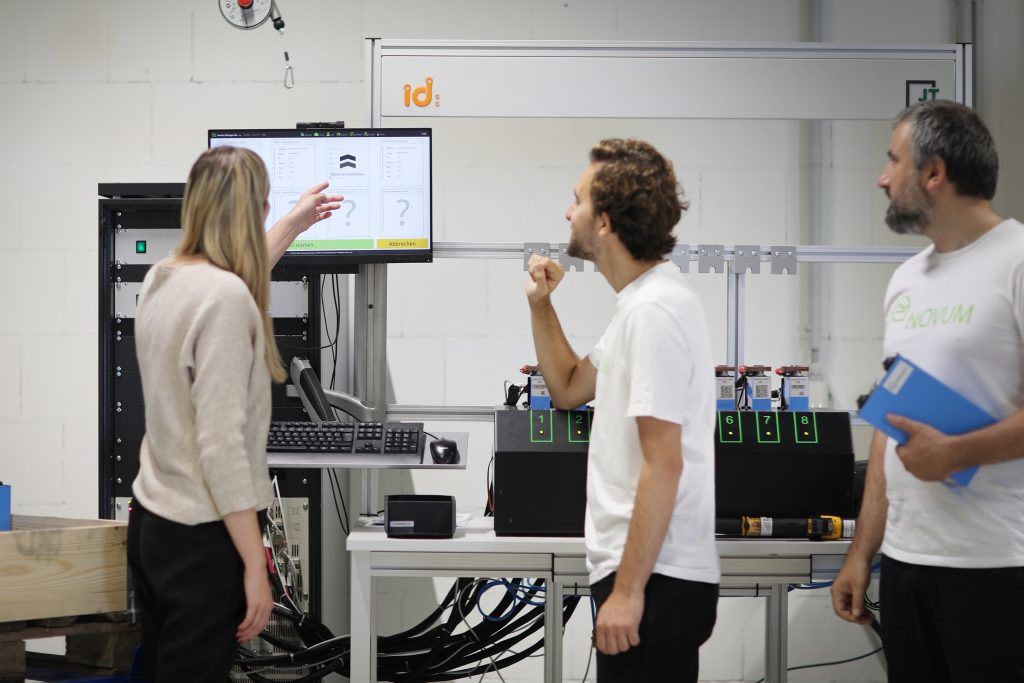There are many different ways of defining the state of health of batteries. The most common is to set the current capacity in relation to the original capacity. A battery is normally considered worn out if this value is below 80 percent. With the help of NOVUM technology, however, such batteries can often be given a second life, for example in a battery storage system.
A second option is to define the state of health of batteries via the internal resistance of batteries. Here too, a battery is considered worn out as soon as certain characteristic values are exceeded.
The third way to define the state of health of batteries is to combine the first two approaches. This definition is used in around ten percent of cases and is quite common in the automotive industry, for example.
Determining the state of health of batteries
Correctly measuring the state of health of batteries is anything but trivial. In order to generate valid values, it is particularly important to create the same conditions for each measurement, e.g. with regard to temperature, state of charge (voltage) or the charging and discharging rate.
Standard SoH test with conventional methods
If the commonly used SoH definition of (residual) capacity is followed, this can be measured approximately by first fully charging and then discharging a battery. In this standard capacity test, the amount of charge that can be taken from the battery is determined during discharge. The result is compared with the original capacity of the battery and the result is a SoH value as a percentage. The decisive factors are the conditions under which the test is carried out and how quickly, i.e. at what C‑rate, the battery is charged and discharged, because only then can the results of different tests and batteries be compared.
As simple as this method is, the test duration is usually problematic, as a single battery test takes five to ten hours in this case. This is costly and inefficient. In addition, the results are not particularly meaningful for certain applications, e.g. when it comes to finding out whether a battery is still suitable for use in battery storage.
Determining the state of health of batteries using AI-based NOVUM technology
At NOVUM, we determine the state of health of batteries using impedance spectroscopy and artificial intelligence. This way of determining the SoH is faster and more cost-effective than conventional methods.
Although we also carry out capacitance and internal resistance measurements, we only need these to train our AI. We always test with exactly the same C‑rate that is to be used for the second-life application of the battery, e.g. in battery storage. We can do this because we permanently monitor batteries during the capacity tests and switch them off immediately if irregularities are detected. This means that battery tests can be carried out safely even at higher C‑rates.

What has a detrimental effect on the state of health of batteries?
Even during production, every battery is characterized by a certain tendency to age. The quality of the materials and processes later affects how good the state of health of batteries is and how quickly it deteriorates. The purity of the materials in the individual cells, the humidity during production and the homogeneity and formation of the cells are particularly decisive.
Batteries age both during use and during storage. This means that even if a battery is only used gently or not at all, its state of health deteriorates over time (calendar ageing). In terms of efficiency, safety and sustainability, it is advisable to delay and control this wear process.
Our AI-based technology helps you to design the use of batteries according to their condition and history so that you can get the most out of each cell. At the same time, we use our AI to ensure that safety risks are eliminated by monitoring batteries around the clock, for example in the battery storage system.
In concrete terms, this means, for example, checking exactly how often a battery should actually be charged and discharged in a particular process in order to delay cyclical ageing and, above all, to avoid deep discharge and overcharging, as both damage the battery. It also means avoiding temperature fluctuations and humidity during use and storage to prevent a sudden drop in performance. With the help of NOVUM’s AI-based monitoring, batteries with a capacity of only 50 percent can continue to be used in the battery storage system.
Does the SoH value of batteries deteriorate linearly?
No, the State of Health drops slowly at the beginning and then suddenly drops rapidly from a tipping point of around 80 percent capacity. Many companies therefore discard batteries at this point, even though they could still be used.
With our technology, we enable you to continue using these valuable, still functional batteries. The key is to move from normal to careful use and to monitor the battery around the clock to ensure the safety and reliability of the equipment.




